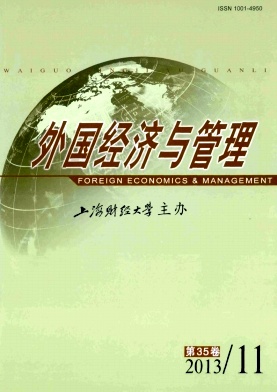国外旅游目的地形象研究前沿探析与未来展望
外国经济与管理 2013 年 第 35 卷第 11 期, 页码:48 - 59
摘要
参考文献
摘要
旅游目的地形象在目的地营销管理中发挥着重要作用。国外学者较早对旅游目的地形象相关问题展开了深入探讨,迄今已有40多年历史。本文按照目的地形象的构成、测量、形成以及对旅游者消费行为的影响四个研究主题,对近十年来国外该领域的研究文献进行了回顾,梳理了国外的最新研究进展,并对未来研究方向进行了展望,以期为国内的旅游目的地营销管理实践和学者们的相关研究提供参考。
[1]Assaker G,et al.Examining the effect of novelty seeking,satisfaction,and destination image on tourists’return pattern:A two factor,non-linear latent growth model[J].Tourism Management,2011,32(4):890-901.
[2]Baloglu S and Brinberg D.Affective images of tourism destination[J].Journal of Travel Research,1997,35(4):11-15.
[3]Baloglu S and McCleary K W.A model of destination images formation[J].Annals of Tourism Research,1999,26(4):868-897.
[4]Beerli A and Martin J D.Tourists’characteristics and the perceived image of tourist destinations:A quantitative analysis—A case study of Lanzarote,Spain[J].Tourism Management,2004a,25(5):623-636.
[5]Beerli A and Martin J D.Factors influencing destination image[J].Annals of Tourism Research,2004b,31(3):657-681.
[6]Castro C B,et al.The influence of market heterogeneity on the relationship between a destination’s image and tourists future behaviour[J].Tourism Management,2007,28(1):175-187.
[7]Chen J S.A case study of Korean outbound travelers’destination images by using correspondence analysis[J].Tourism Management,2001,22(4):345-350.
[8]Echtner C M and Ritchie J R B.The meaning and measurement of destination image[J].Journal of Tourism Studies,1991,2(2):2-12.
[9]Echtner C M and Ritchie J R B.The measurement of destination image:An empirical assessment[J].Journal of Travel Research,1993,31(4):3-13.
[10]Elliot S,et al.An integrative model of place image:Exploring relationships between destination,product,and country images[J].Journal of Travel Research,2011,50(5):520-534.
[11]Frías D M,et al.Internet vs.travel agencies on pre-visit destination image formation:An information processing view[J].Tourism Management,2008,29(1):163-179.
[12]Frías D M,et al.The formation of a tourist destination’s image via information sources:The moderating effect of culture[J].International Journal of Tourism Research,2012,14(5):437-450.
[13]Gallarza,et al.Destination image towards a conceptual framework[J].Annals of Tourism Research,2002,29(1):56-78.
[14]Gil S M and Ritchie J R B.Understanding the museum image formation process:A comparison of residents and tourists[J].Journal of Travel Research,2009,47(4):480-493.
[15]Hong S K,et al.The roles of categorization,affective image and constraints on destination choice:An application of the NMNL model[J].Tourism Management,2006,27(5):750-761.
[16]Hsu C H C,et al.Image assessment for a destination with limited comparative advantages[J].Tourism Management,2004,25(1):121-126.
[17]Jeong C,et al.Enhancing destination image through travel website information[J].International Journal of Tourism Research,2012,14(1):16-27.
[18]Kim S S,et al.Tracking tourism destination image perception[J].Annals of Tourism Research,2009,36(4):715-718.
[19]Lai K and Li Y.Core-periphery structure of destination image:Concept,evidence and implication[J].Annals of Tourism Research,2012,39(3):1359-1379.
[20]Lin C H,et al.Examining the role of cognitive and affective image in predicting choice across natural,developed,and theme-park destinations[J].Journal of Travel Research,2007,46(2):183-194.
[21]Litvin S W and Mouri N.A comparative study of the use of“iconic”versus“generic”advertising images for destination marketing[J].Journal of Travel Research,2009,48(2):152-161.
[22]Martin H S and Bosque I A R D.Exploring the cognitive-affective nature of destination image and the role of psychological factors in its formation[J].Tourism Management,2008,29(2):263-277.
[23]Nadeau J,et al.Destination in a country image context[J].Annals of Tourism Research,2008,35(1):84-106.
[24]Pan B and Li X.The long tail of destination image and online marketing[J].Annals of Tourism Research,2010,38(1):132-152.
[25]Pike S.Repertory Grid Analysis in group settings to elicit salient destination image attributes[J].Current Issues in Tourism,2007,10(4):378-392.
[26]Sirakaya E,et al.Do destination images really matter?Predicting destination choices of student travelers[J].Journal of Vacation Marketing,2001,7(2):125-142.
[27]Snmez S and Sirakaya E.A distorted destination image?The case of Turkey[J].Journal of Travel Research,2002,41(11):185-196.
[28]Stepchenkova S and Morrison A M.Russia’s destination image among American pleasure travelers:Revisiting Echtner and Ritchie[J].Tourism Management,2008,29(3):548-560.
[29]Yang J,et al.The implicit measurement of destination image:The application of implicit association tests[J].Tourism Management,2012,33(1):50-52.
[30]Yuksel A and Akgul O.Postcards as affective image makers:An idle agent in destination marketing[J].Tourism Management,2007,28(3):714-725.
①三个开放式问项分别为:(1)当你想到度假目的地×××时,你会想到它的什么形象或特征?(2)当你到访×××时,你如何形容你所期望体验到的氛围或情感?(3)请列出任何你能够想到的关于×××的独特或唯一的旅游吸引物。
[2]Baloglu S and Brinberg D.Affective images of tourism destination[J].Journal of Travel Research,1997,35(4):11-15.
[3]Baloglu S and McCleary K W.A model of destination images formation[J].Annals of Tourism Research,1999,26(4):868-897.
[4]Beerli A and Martin J D.Tourists’characteristics and the perceived image of tourist destinations:A quantitative analysis—A case study of Lanzarote,Spain[J].Tourism Management,2004a,25(5):623-636.
[5]Beerli A and Martin J D.Factors influencing destination image[J].Annals of Tourism Research,2004b,31(3):657-681.
[6]Castro C B,et al.The influence of market heterogeneity on the relationship between a destination’s image and tourists future behaviour[J].Tourism Management,2007,28(1):175-187.
[7]Chen J S.A case study of Korean outbound travelers’destination images by using correspondence analysis[J].Tourism Management,2001,22(4):345-350.
[8]Echtner C M and Ritchie J R B.The meaning and measurement of destination image[J].Journal of Tourism Studies,1991,2(2):2-12.
[9]Echtner C M and Ritchie J R B.The measurement of destination image:An empirical assessment[J].Journal of Travel Research,1993,31(4):3-13.
[10]Elliot S,et al.An integrative model of place image:Exploring relationships between destination,product,and country images[J].Journal of Travel Research,2011,50(5):520-534.
[11]Frías D M,et al.Internet vs.travel agencies on pre-visit destination image formation:An information processing view[J].Tourism Management,2008,29(1):163-179.
[12]Frías D M,et al.The formation of a tourist destination’s image via information sources:The moderating effect of culture[J].International Journal of Tourism Research,2012,14(5):437-450.
[13]Gallarza,et al.Destination image towards a conceptual framework[J].Annals of Tourism Research,2002,29(1):56-78.
[14]Gil S M and Ritchie J R B.Understanding the museum image formation process:A comparison of residents and tourists[J].Journal of Travel Research,2009,47(4):480-493.
[15]Hong S K,et al.The roles of categorization,affective image and constraints on destination choice:An application of the NMNL model[J].Tourism Management,2006,27(5):750-761.
[16]Hsu C H C,et al.Image assessment for a destination with limited comparative advantages[J].Tourism Management,2004,25(1):121-126.
[17]Jeong C,et al.Enhancing destination image through travel website information[J].International Journal of Tourism Research,2012,14(1):16-27.
[18]Kim S S,et al.Tracking tourism destination image perception[J].Annals of Tourism Research,2009,36(4):715-718.
[19]Lai K and Li Y.Core-periphery structure of destination image:Concept,evidence and implication[J].Annals of Tourism Research,2012,39(3):1359-1379.
[20]Lin C H,et al.Examining the role of cognitive and affective image in predicting choice across natural,developed,and theme-park destinations[J].Journal of Travel Research,2007,46(2):183-194.
[21]Litvin S W and Mouri N.A comparative study of the use of“iconic”versus“generic”advertising images for destination marketing[J].Journal of Travel Research,2009,48(2):152-161.
[22]Martin H S and Bosque I A R D.Exploring the cognitive-affective nature of destination image and the role of psychological factors in its formation[J].Tourism Management,2008,29(2):263-277.
[23]Nadeau J,et al.Destination in a country image context[J].Annals of Tourism Research,2008,35(1):84-106.
[24]Pan B and Li X.The long tail of destination image and online marketing[J].Annals of Tourism Research,2010,38(1):132-152.
[25]Pike S.Repertory Grid Analysis in group settings to elicit salient destination image attributes[J].Current Issues in Tourism,2007,10(4):378-392.
[26]Sirakaya E,et al.Do destination images really matter?Predicting destination choices of student travelers[J].Journal of Vacation Marketing,2001,7(2):125-142.
[27]Snmez S and Sirakaya E.A distorted destination image?The case of Turkey[J].Journal of Travel Research,2002,41(11):185-196.
[28]Stepchenkova S and Morrison A M.Russia’s destination image among American pleasure travelers:Revisiting Echtner and Ritchie[J].Tourism Management,2008,29(3):548-560.
[29]Yang J,et al.The implicit measurement of destination image:The application of implicit association tests[J].Tourism Management,2012,33(1):50-52.
[30]Yuksel A and Akgul O.Postcards as affective image makers:An idle agent in destination marketing[J].Tourism Management,2007,28(3):714-725.
①三个开放式问项分别为:(1)当你想到度假目的地×××时,你会想到它的什么形象或特征?(2)当你到访×××时,你如何形容你所期望体验到的氛围或情感?(3)请列出任何你能够想到的关于×××的独特或唯一的旅游吸引物。
引用本文
沈雪瑞, 李天元. 国外旅游目的地形象研究前沿探析与未来展望[J]. 外国经济与管理, 2013, 35(11): 48–59.
导出参考文献,格式为:
下一篇:国外非营利组织品牌研究述评与展望





 6883
6883  420
420

